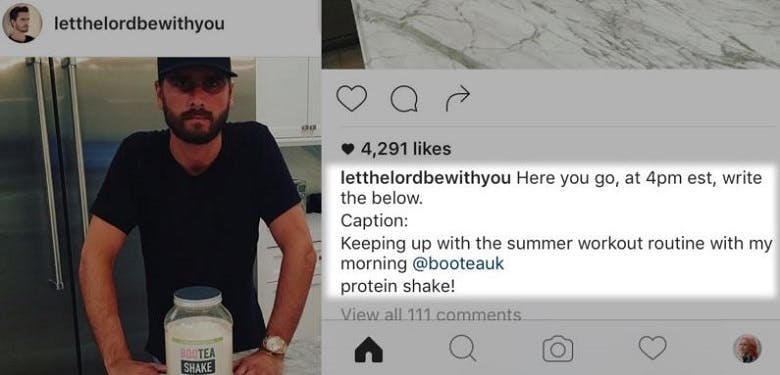Rakuten Marketing found that 75% of marketers plan to spend even more on influencers in the months to come, while Celebrity Intelligence says that digital influencers are the most popular choice for brand endorsements.
But while this indicates that the industry is booming, it’s hard to ignore murmurings that it could also be in danger of bursting. From fake Instagram ‘pods’ to troubles with attribution – there are certainly many issues to tackle.
So, is influencer marketing really a safe bet for 2018? Here’s bit more on the state of the industry, and what marketers can do to minimise the risks involved.
Fraud and fakes
Authenticity and trust is key to any successful influencer campaign, as consumers become all the more sceptical when it comes to forced and purely-commercial partnerships.
One common example is the one-off paid Instagram post, whereby celebrities or influencers are paid to promote a particular product or service. Sometimes, this can work out fine – if the influencer in question is a natural fit or genuinely uses the product. On the other hand, it can also result in failure.
We’ve previously seen the likes of Scott Disick and Naomi Campbell demonstrate disingenuous brand partnerships, having clearly copied and pasted pre-written copy on their paid-for posts.

Similarly, even when the quality of the content is greater, disclosure remains a huge problem across the board. Many influencers fail to highlight when a post is sponsored or if there has been brand involvement. In turn, this contributes to a lack of trust from a consumer perspective, and in the worst cases, result in punishment from the FTC or ASA.
Alongside this lack of authenticity, blatant fraud is also plaguing the industry, with influencers now using so-called ‘instapods’ to artificially enhance their number of followers or likes. These pods are made up of 30 or so people who commit to commenting on or engaging with each other’s posts, with the end-goal being to get noticed by brands and earn money.
Of course, this also means that any campaign involving an artificially-enhanced influencer will be based on skewed data – which also means the brand will potentially be backing a dud, as the influencer could have no actual influence or effect on a real-life audience.
Measuring ROI
According to Rakuten, investment in influencer marketing is still on the up. Marketers are reportedly willing to pay in excess of £100,000 for a single post mentioning their brand, and yet, a massive 86% of marketers admit that they aren’t entirely sure how influencer fees are calculated.
Celebrity Intelligence’s Age of Social Influence report also highlights confusion around ROI, with marketers finding it difficult to measure true success, and instead relying on outdated metrics such as mainstream press coverage.
The report states that just 41% of respondents say they are measuring revenue generation, and just 29% say they are using trackable attribution links within influencer content.

Altogether, this means that the potential for fraud is further increased, with brands unable to differentiate between real and fake engagement.
Last July, MediaKix demonstrated just how easy it is for influencers to pull the wool over brands’ eyes, creating two fake profiles made up of stock images. After just two months, both accounts had accumulated thousands of (paid-for) followers and had misleadingly high engagement levels. On the back of this, MediaKix secured four brand endorsement deals, with influencer content eventually being exchanged for money and free products.
This goes to show the need for greater or perhaps more diverse measurement, which takes into account a wider variety of metrics (and not just the most obvious).
Advocacy or influence?
Finally, another reason investment in influencer marketing might not come to fruition could be due to changes in what actually generates real success.
Last year, the general consensus seemed to be that micro-influencers were the key – i.e. individuals with 10,000 to 100,000 followers and theoretically a highly engaged audience. However, it has been suggested that the trend is perhaps a scam started by influencer marketing platforms. Essentially, as brands work with an increasing pool of small-scale influencers, ‘high’ engagement levels could be misleading – failing to translate to legitimate or large-scale impact, as well as diluting the quality of content.
Looking at alternatives, some have suggested that advocacy could be the next big trend, with user-generated content potentially leading to higher levels of engagement.
So, what’s the difference between influence and advocacy? In broad terms, it seems the former is focused on driving awareness, while the latter is much more laser-focused on helping others to have the same positive experience as them.
Advocates can therefore be anyone that has experienced a brand or product, regardless of the size of their social media audience or how much engagement they have previously generated. This point is the key, as it ultimately takes away the competition element (and even the danger of fraud) as selection is purely based on genuine promotion and support for brands.

The road to success
So, does this mean that brands will turn their back on larger influencers for everyday folk? Maybe not entirely, as research suggests that the strategy in its original form – i.e. utilising the power of known and trusted individuals – can still be of great benefit.
However, it might also mean that marketers will be more fluid within their strategies, utilising a wide range of influencers (and channels) rather than the most obvious or mainstream tactics. This could mean focusing on both user-generated content as well as larger influencers, most importantly depending on what is the best fit for the audience and their values.
Perhaps then, instead of valuing the influencer’s audience (in terms of numbers), brands should start to focus more on who their own audience is following and why.
More on influencer marketing:

Comments